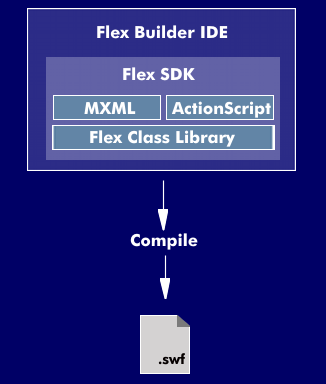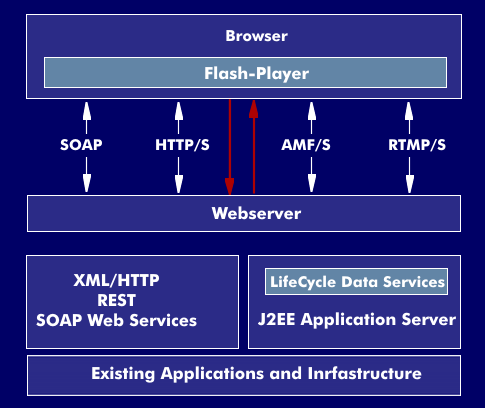Adobe Flex
The Adobe Flex development framework is used to create interactive user interfaces for web and desktop applications - so-called Rich Internet Applications( RIA). The basis of a Flex application is the MXML markup language and the ActionScript 3.0 object-oriented programming language.
The prerequisite for running Flex applications is the prior installation of a player version 9.x on the client. This is available for free download for Windows, Linux, and Mac OS from the Adobe website via the link below. The components for creating a Flex application - the Software Development Kit( SDK) and the framework - are also available from Adobe as open source via the aforementioned link.
FlexBuilder as a professional development environment
With the Flex Builder, there is also a professional development environment for Flex applications - but this is subject to a fee.
The starting point for an application is in Flex MXML and ActionScript 3.0 (AS3). In addition, the framework provides a large number of directly usable components, which are stored in the Flex class library. MXML is used to describe the user interface and is a so-called declarative markup language. In contrast to HTML, MXML also provides abstractions for the logical relationships in the presentation layer of an application and the connection of the user interface with server-side data. A key aspect of MXML (Macromedia Flex Markup Language) is the separation of the presentation layer and the business logic. This is then in turn described by the use of AS3. AS3 is a programming language that implements object-oriented concepts, and its structure shows influences from Java and JavaScript. The Flex developer can describe for example with support of AS3 event listeners and appropriate -Handler, which retrieve then on the other hand values of component properties and/or specify.
The connection of MXML and AS3 to an application interface is integrated by the compiler. The compiler first transforms all MXML descriptions into AS3 classes and, together with the AS3 business logic, generates a so-called SWF file, which can then be integrated into an Internet page in the usual way. The SWF file format (pronounced: swiff, origin: Shockwave by Macromedia) defines a special format for computationally intensive data and supports vector graphics and animations, text, bitmap formats (JPG, PNG), sound formats(WAV, MP3) and video formats( MOV, AVI, MPEG). The execution of the website with the integrated Flex application is then realized by the virtual machine of the browser, which is available as a plug-in. In any case, a player of at least version 9.x must be installed on the executing system beforehand.
Creating Flex applications
For the creation of a Flex application with the associated MXML and AS3 files, a simple text editor is generally sufficient. However, its handling quickly becomes confusing for more complex projects. In this case, Flex Builder provides a development environment based on the structure of Eclipse. Flex Builder then integrates all parts of the framework and the compiler - but is chargeable in unlimited version.
Another component is the so-called LiveCycle Data Service, which was previously also called Flex Data Service. This consists of the core components: Proxy Service, Remote Object Service, Message Service, and Data Management Service.
These services enable integration in enterprise server applications. On the application side, the Flex Data Services are available to them and are ultimately used to integrate data into a Flex application. Three different RPC services are available for this purpose: the HTTPService, the WebService, and the RemoteObject.
In Flex, all data requests are handled asynchronously.
Finally, summarize the advantages and disadvantages of Flex. Its advantages:
- The application is completely loaded on the client.
- Only the business data is transported over the network.
- With LiveCycle Data Services, a mature technology is available in the back-end area.
- Flex Builder is a professional development environment.
- Flash Player plug-in is available for almost any browser.
- Flex applications are platform independent.
The disadvantages of Flex:
- Upload to client can take noticeable time for the first time.
- Must have a version of Flash Player 9.x installed.
- Flex Builder is available for a fee.
- LiveCycle Data Service is chargeable if more than one central processing unit( CPU) is used.


